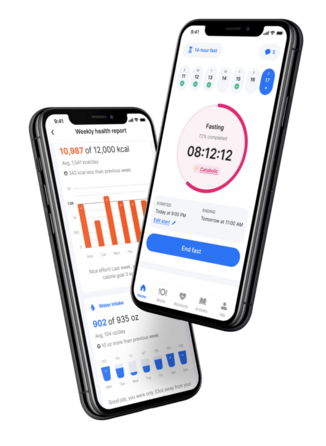Contents
What Is the Dubrow Diet?
The Dubrow diet is a three-phase eating schedule that combines intermittent fasting methods with a low-carb diet to boost metabolism and reduce hunger cravings. The diet sets out specific foods you can eat, including non-starchy vegetables, lean proteins, healthy fats, and complex carbs.
This plan was created by American reality stars Terry and Heather Dubrow, who summarized it in their 2018 book “The Dubrow Diet.”
This eating method is divided into three phases, all designed to help you achieve your goal weight and then maintain it. It also differs from other very low-calorie diet types in that it doesn’t set specific calorie limits: as long as the foods you eat are included in the diet, you can eat as much as you want.
Take a
1-minute quiz
and discover how much weight you can lose with DoFasting!

The Dubrow diet vs. intermittent fasting
The Dubrow diet integrates elements of intermittent fasting: in the first of the three phases, dieters are expected to follow a 16:8 periodic fasting method, where they fast for 16 hours and eat for 8.
In the second phase, which lasts until you reach your goal weight, you fast for between 12 and 16 hours, depending on how much weight you want to lose and how quickly.
Intermittent fasting does not restrict what you can eat, but the Dubrow diet does. This method restricts your intake to foods including lean protein, healthy fats, and non-starchy vegetables to ensure you’re eating at a lower carb rate.
How Does the Dubrow Diet Work?
As already mentioned, the Dubrow diet is split into three separate phases. Each of them has a different goal and a different time limit, but they all bring you closer to your target weight:
- The first phase is designed to reset the system and prepare your body for weight loss.
- The second phase is when you’ll actually start losing weight.
- And then, the final phase of the Dubrow diet plan is made to maintain your target weight.
Let’s look at these phases in more detail.
Phase 1: “Red carpet ready”
The first phase of the Dubrow diet is called the “Red carpet ready” phase. This phase is incredibly restrictive and should be followed for 2 to 5 days at the beginning of the diet. The idea is that this phase will reset the body, reduce hunger cues, and help you start losing weight with a blank slate.
This stage involves eating foods like lean proteins, healthy fats, non-starchy veg, fruits, dairy, nuts and seeds, and a small number of complex carbs. In this phase, you would follow a 16:8 style of intermittent fasting plan, meaning you would eat for 8 hours of the day and fast for the other 16 hours.
Phase 2: “Summer is coming”
The second phase, known as “Summer is coming,” is meant to be followed until you achieve your desired weight. Similarly to the first phase, you follow an interval eating plan, but you can fast for between 12 and 16 hours each day.
The amount of time you choose to fast for will depend on how much weight you want to lose and how fast you want to do it. Fasting for extended periods will likely help you shed excess weight faster, but it will be much more challenging.
Though this method doesn’t require you to count the calories you eat, the food allowance in this second phase is more restrictive. Your daily meal plan should include:
- 2-3 servings of non-starchy vegetables
- 2-3 servings of different lean proteins
- 2-3 servings of healthy fats
- 1 serving of a dairy product
- 1-2 servings of fruit
- 1 serving of nuts or seeds
- 1 serving of complex carbohydrates
This low-carb interval eating phase is designed to help you nourish your body while still losing weight.
Phase 3: “Look hot while living like a human”
The last phase, known as “Look hot while living like a human,” is designed for weight maintenance in the long term. As with the second phase, here you will need to commit to interval eating, but the pattern changes.
Two days a week, you would fast for 16 hours and eat for 8. On the remaining five days of the week, you would need to follow a 12-hour fasting plan, meaning you eat for 12 hours and fast for the other 12.
In both the second and third phases of the diet, you may have cheat days consisting of your favorite foods—but you should still consume them in moderation.
Foods to Eat on the Dubrow Diet
Foods you may eat on this diet include:
- Non-starchy vegetables — broccoli, celery, cauliflower, artichoke, etc.
- Lean proteins — fatty fish, chicken, tofu, etc.
- Healthy fats — avocado, olive oil.
- Complex carbs — whole grains and starchy vegetables (although these should be kept to one serving per day to keep your carb intake low).
Foods to Avoid on the Dubrow Diet
The success of your Dubrow diet journey depends entirely on your regular intake of healthy foods. To make room for those, you must let go of other less nourishing options like:
- Processed food products — frozen meals, takeaway, fast food, pastries and other baked goods, sweets, chocolate bars, etc.
- Refined grains — white bread, pasta, biscuits, white rice, etc.
- Sugar-sweetened beverages — energy drinks, cola, soda, sweet teas, sports drinks, etc.
- High-fat meats — bacon, steak, sausages, etc.
- Refined oils — canola oil, soybean oil, trans fats, etc.
How Does the Dubrow Diet Help You Lose Weight?
As you already know, this diet puts a significant emphasis on healthy, whole foods, as it encourages you to eat from all food groups and to include more beneficial fats in your diet. This regime is also low in carbohydrates, just like the keto diet. Low-carb diets like these have been shown to promote weight loss by reducing hunger and increasing satiety.
The Dubrow method also uses intermittent fasting to aid weight loss, which has been proven helpful for this purpose, as it helps the body shed excess fat.
The logic behind intermittent fasting is pretty straightforward: fasting enforces a calorie deficit and boosts metabolism by reducing the amount of time you have to eat, while also leading the body into a state called ketosis, in which the body burns fat for fuel over blood sugar.
Take a
1-minute quiz
and discover how much weight you can lose with DoFasting!

Other Health Benefits of the Dubrow Diet
Along with helping you lose body weight, the Dubrow diet has other interesting health benefits.
Emphasis on whole, minimally processed foods
There is much research into how a diet filled with whole, healthy, and minimally processed foods can impact your health. In fact, it is well known that any diet that prioritizes these food groups can reduce your risk of developing illnesses like some cancers, heart disease, and diabetes.
Diets like the Dubrow regime are also considered heart-healthy diets, and may help you reduce your risk of cognitive decline and neurodegenerative disease.
May protect against chronic diseases
Both intermittent fasting and a whole and healthy diet are thought to reduce your risk of chronic disease. This is because they help fight inflammation, which is directly linked to severe, lifelong conditions.
IF also increases autophagy, a process in which the body breaks down and reuses old cell parts that can help prevent and even improve symptoms in several chronic and neurodegenerative illnesses.
Improves blood sugar control
The Dubrow diet’s combination of a whole-food diet with intermittent fasting is an excellent approach to lowering blood sugar and improving regulation.
There is evidence that shows that low-carb diets can have a profound impact on blood sugar control, particularly in individuals with type 2 diabetes or prediabetes.
May promote brain function
There is also evidence that this diet can improve brain function: studies show that intermittent fasting can enhance brain structures and cognition, which are also benefits of low-carb diets. By combining these two strategies, the Dubrow method can be a good choice for those concerned about the long-term health of their brains.
May improve heart health
Fasting, eating more whole foods, and having a low-carb intake have all been shown to promote heart health. The combination of these factors is thought to reduce cardiovascular risk by lowering triglyceride levels, cholesterol, and blood pressure.
Downsides and Risks to Consider
As with any diet, there are drawbacks and risks you should be aware of. We have summarized them below.
May cause a yo-yo diet effect
Yo-yo dieting is when your weight increases and decreases in cycles over long periods, which is induced by diets where you lose lots of weight at once. This can happen after you have lost weight on a diet, and then go back to eating normally again, only to put all the weight back on again.
Yo-yo dieting may have long-term consequences for your health, including putting you at greater risk of illness later in life.
To avoid this, it’s essential to understand that your change of habits is a lifelong commitment to yourself. You should keep prioritizing healthy meals and lifestyle choices for the benefits mentioned above to last more than a few months.
Possibly restrictive in terms of calories
Though the diet doesn’t necessarily restrict calories, it limits your eating hours. In the end, by following it, you will probably eat fewer calories than usual.
Not eating enough calories each day can cause several problems, including lack of focus, weakness, and irritability.
While following the Dubrow method, make sure that you’re getting all the nutrients you need, and remember: for a safe weight loss journey, women are recommended to consume at least 1,200 calories per day, while men should eat at least 1,500 calories.
Emphasis on physical appearance
Although this method offers many health benefits beyond dropping some pounds, the Dubrow diet is primarily marketed as a weight loss plan.
An emphasis on losing weight can cause some to develop an unhealthy relationship with food, which may lead to eating disorders.
When following this or any other regime eating habit, remember that your health is more important than your appearance. And if at any point you feel that you’re developing an unhealthy relationship with food, or that losing weight is becoming an obsession rather than a goal, stop the diet and seek medical or psychological help as soon as possible.
Not suitable for people with certain health conditions
Certain groups of people should refrain from trying this diet, as in their cases, this change of habits can have more negative effects than benefits:
- People with a history of eating disorders.
- Anyone with an illness that would be exacerbated by fasting.
- Those with sleep conditions.
- Pregnant or breastfeeding people.
Always speak with your doctor before trying a new diet to ensure that it is suitable for you and that it won’t have any negative consequences for your health.
Try DoFasting to Get the Most Out of Intermittent Fasting
If you’re considering trying this diet, you might want to take a look at the DoFasting app. There, you’ll find lots of recipes that fit the requirements of the Dubrow method, an intuitive timer that’ll help you keep track of your fasting windows, workouts for all levels, a calorie tracker, and more.
Additionally, their library offers many resources that can help you clear any doubts about fasting and nutrition you may have—all you need for a smooth transition into your new habits.
Take a
1-minute quiz
and discover how much weight you can lose with DoFasting!

Conclusion
The Dubrow diet is a weight loss method that combines a low-carb, whole-food diet with intermittent fasting. This eating pattern can promote weight loss, but it also has overall health benefits like protection against chronic diseases, better blood pressure, improved heart function, and more.
While this regime has many positives, it’s essential to understand that it’s a short-term plan that cannot be followed forever. For long-lasting results, choose healthy lifestyle options you can stick to, like picking nourishing foods over processed meals, regular exercise, or even intermittent fasting.
See how DoFasting will improve your life
Find out what works for you with this 60-sec quiz approved by our experts and get your personal revolutionary fasting assistant.
Start the Quiz














